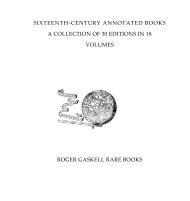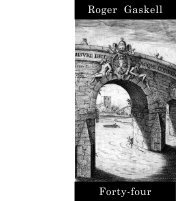pdf - Roger Gaskell Rare Books
pdf - Roger Gaskell Rare Books
pdf - Roger Gaskell Rare Books
You also want an ePaper? Increase the reach of your titles
YUMPU automatically turns print PDFs into web optimized ePapers that Google loves.
4to, pp. xviii 152.<br />
4 engraved plates highlighted with coloured washes, signed ‘Dr Müller<br />
ad nat. del.’ and numbered Tab I–IV (bound at end).<br />
260 x 205mm. Intermittent foxing; plates discoloured.<br />
Binding: Later nineteenthcentury cloth backed boards. Corners worn.<br />
Provenance: Mathias Duval (1844–1907) with his address label on<br />
upper board and pastedown.<br />
First edition.<br />
‘In his Bildungsgeschichte der Genitalien he clariWed the very complicated<br />
relationships between the initial form of the kidneys and their ducts, on<br />
the one hand, and the sexual organs, on the other. He discovered that the<br />
embryonic duct (described by Heinrich Rathke) now called “Müller’s duct”<br />
forms the Fallopian tubes, uterus, and vagina: only rudiments of it are found<br />
in the male.’ (Johannes Steudel, DSB 9:570b.)<br />
This monograph traces the development of the Müllerian ducts into the<br />
female organs, their development being inhibited in the male. The discovery<br />
of the ducts was Wrst reported by Müller in a journal article in 1825 (see<br />
Garrison–Morton 475).<br />
This copy has an important provenance, having belonged to Mathias<br />
Duval (1844–1907) one of the pioneers of placental histology and author of<br />
Le placenta des rongeurs (1890–1892).<br />
142<br />
MÜLLER, Johannes Peter (1801–1858)<br />
Ueber den Bau und die Grenzen der Ganoiden und über das<br />
natürliche System der Fische.<br />
Berlin, 1846.<br />
8vo, pp. 91–141.<br />
210 x 125mm. Light browning.<br />
Binding: Recent quarter morocco, original plain front wrapper<br />
preserved.<br />
Provenance: Presentation inscription on on wrapper and a 5line<br />
note addressed to ‘Dr Ludwig’ in the author’s hand (Carl Friedrich<br />
Wilhelm Ludwig, 1816–1895), and 5 corrections in the text (one<br />
slightly cropped); Art Nouveau bookplate of Charles Atwood.<br />
Extract from Archiv für Naturgeschichte 11(1845), 91–141.<br />
From the 1830’s Müller had worked on zoological classiWcation and from about<br />
1840 he devoted most of his time to comparative anatomy and zoology.<br />
This journal extract was sent by the author, so presumably there was no<br />
oVprint. The recipient was Carl Friedrich Wilhelm Ludwig (1816–1895),<br />
appointed associate professor at Marburg in the following year. George Rosen<br />
describes Ludwig as one of ‘that remarkable group of German physiologists<br />
and teachers who in the latter half of the nineteenth century created modern<br />
physiology’ (DSB 8:541b).







